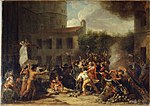Charles Thévenin
Charles Thévenin | |
|---|---|
Dominique Ingres (1817). | |
| Born | Charles Thévenin 12 July 1764 Paris, France |
| Died | 28 February 1838 (aged 73) |
| Nationality | French |
| Education | Académie royale de peinture et de sculpture |
| Known for | painting |
| Movement | Neoclassicism |
Charles Thévenin (12 July 1764 – 28 February 1838) was a neoclassical French painter, known for heroic scenes from the time of the French Revolution and First French Empire.
Biography
Born in Paris, the son of a court architect, Charles studied painting at the Académie royale de peinture et de sculpture under François-André Vincent. Winning second prize in the prix de Rome for Joseph recognised by his brothers in 1789, he won first prize in 1791 for Regulus returns to Carthage.
Thus he received his first commissions and in 1790 produced the first version of The Taking of the Bastille, which produced a number of commentaries. He received a second prize at the Concours of Year II for The 12 July 1789.
After giving up history painting for decorative subjects for a time, in 1798 he produced
Works

- Joseph reconnu par ses frères (1789). Musée des Beaux-Arts, Angers.
- Un vainqueur de la Bastille (1789). Musée Carnavalet, Paris.
- La Vengeance du peuple après la prise de la Bastille ou Assassinat du Marquis de Pelleport (1789–90). Musée Carnavalet, Paris.
- Le Marquis de Launay, gouverneur de la Bastille, capturé par les assaillants le 14 juillet 1789 (1789–93). Musée Carnavalet, Paris.
- La Prise de la Bastille (eau-forte, 1790). Bibliothèque nationale de France, Paris.
- Régulus retourne à Carthage (1791). École nationale supérieure des Beaux-Arts, Paris.
- La Fête de la Fédération, le 14 juillet 1790, au Champ-de-Mars (1792). Musée Carnavalet, Paris.
- Œdipe et Antigone (v. 1795–96). Assemblée nationale, Paris.
- Augereau au pont d’Arcole, 15 novembre 1796 (1798). Musée national du Château de Versailles.
- Jean-Baptiste de Monet, Chevalier de Lamarck (1802–03).
- Abbaye de St. Martin de Sées (v. 1810).
- Reddition de la ville d’Ulm, le 20 octobre 1805, Napoléon Ier recevant la capitulation du général Mack (1815)
Gallery
-
The Festival of the Fédération, 14 July 1790, on the Champ-de-Mars (1792)
-
The Taking of the Bastille (1793)
-
Augereau on the bridge at Arcole, 15 November 1796 (1798)
-
Surrender of the town of Ulm, 20 October 1805, Napoleon I receives the capitulation of general Mack (1815)
-
Oedipus and Antigone, Aberdeen Archives, Gallery & Museums Collection





